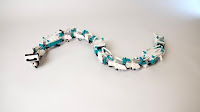MINDSTORMS recently added a new feature to the Robot Inventor that allows creators to connect two or more hubs together. These new programming blocks allow for new and creative multi-hub projects where one hub can communicate with another. Hub-to-hub communication opens up endless possibilities for creating remote control applications, dance companions, games, and complex animals.
Below are some inspirational projects that use two or more hubs that are created by the ROBOTMAK3RS, a global community of robot experts. You can find most of these projects in the official the MINDSTORMS App in the Community section. Both building instructions and code available for you to try out.
Get ready for a competitive, fast-paced multi-player game. Sanjay and Arvind Seshan (USA) create a quick-to-build multiplayer racing game called Color Catcher. This game allows two players to race to the color that is displayed on the hub. Players navigate their robot by using the buttons on the hub to pick a direction and then tap on the hub itself to make their robot move in that direction. The first player to successfully “catch” the color scores a point.
Dimitri Dekyvere (Belgium) and Laurens Valk (the Netherlands) use two hubs to create an engaging balancing robot with an accompanying remote control. Using the joystick, you can control the Balancing Bot with your second hub.
Always dreamed of training to become an astronaut? With the Shuttle Simulator by Nard Strijbosch (the Netherlands) you can start your journey! Nard uses two hubs to create a Shuttle Simulator that is sure to test your piloting skills. One hub serves as a shuttle and the other as the controller. The player can fly the shuttle using the controller.
You may have thought that Charlie is an excellent drummer. It turns out Charlie is also an excellent dance instructor! This fun and interactive project is sure to bring a lot of smiles. Anika Brandsma (the Netherlands) recreates a Dance Class using two hubs. The human dancer holds a hub in one hand and imitates Charlie’s movements.





